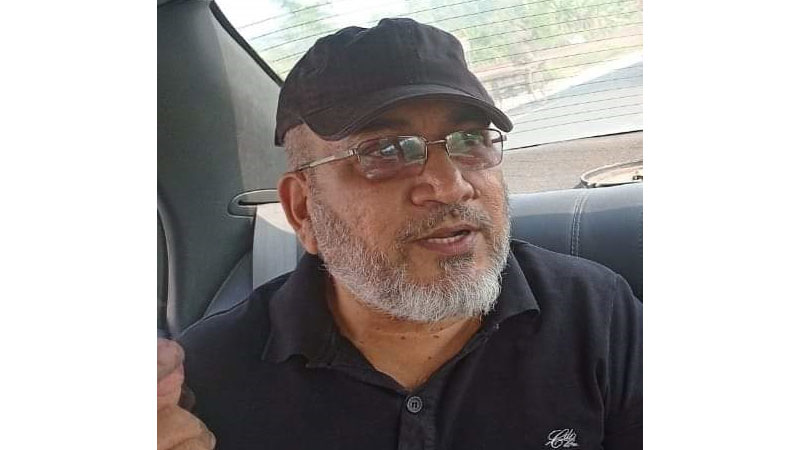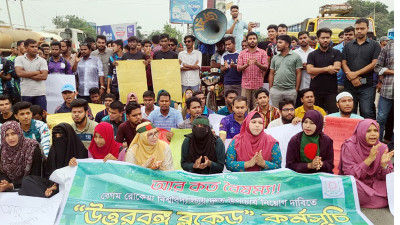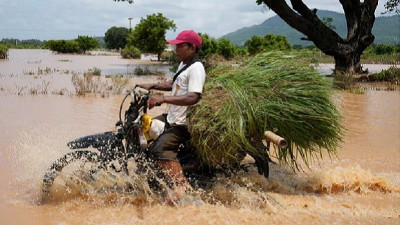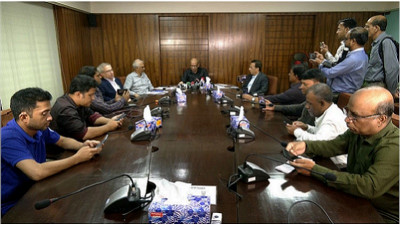 Photo: Collected
Photo: Collected Brigadier
General (Retd.) Mohammad Hasan Nasir, former director of Army Headquarters, was
a member of the national investigation commission led by Secretary Anisuzzaman,
which was formed after the 2009 BDR mutiny to investigate the killings.
Recently, General (Retd.) Moeen U Ahmed, who was the army chief at the time,
made statements about the events of the day of BDR mutiny. Brigadier General (Retd.) Mohammad Hasan Nasir spoke to Bonik Barta
about those statements and the investigation. Interviewed by Anika
Mahjabin, transcribed by Arfin
Soriyat.
Former
army Chief Moeen U Ahmed stated that he learned about the disturbance at
Pilkhana around 9:30 am. Shortly after, he attempted to contact the former
prime minister, but found her phone busy. He then immediately ordered the 46
Brigade to prepare for an operation, later named ‘Operation Restore Order’. Is
it true that he issued the order to prepare for the operation right after
receiving the information?
There’s
a standing procedure in the army when it comes to preparations. Whenever
there’s a potential emergency, an order is given for preparations, and time is
allotted for it. This doesn’t mean soldiers are ordered to participate in the
operation; it simply means, “Get ready.”
According
to Moeen U Ahmed, he was able to contact the former prime minister at 9:54 am,
at which time Sheikh Hasina authorized the 46 Brigade to move toward Pilkhana.
Within an hour of receiving permission, the brigade set off for Pilkhana under
the leadership of their brigade commander.
That
timeline is incorrect. The army’s first detachment reached Pilkhana at
approximately 10:30 am, having come from the Mirpur Cantonment.
Whose
order was it?
This
is correct. Under the orders of both his (the then army chief) and the 46
Brigade commander, the first artillery detachment passed through Jahangir Gate
and moved toward Pilkhana. They arrived at Pilkhana at 10:30 am. Did he
cooperate with the situation there?
So
far, that’s correct. He ordered them to go, but didn’t order them to initiate
an operation. They stationed themselves there and awaited further orders.
No
operation until then?
No,
no. No operation took place until the evening of February 26. Thirteen officers
were killed between 10:30 and 11 am on the morning of February 25.
Moeen
U Ahmed said the 46 Brigade vehicle arrived at the main gate at 11 am.
The
first unit of the 46 Brigade arrived at Gate 4 around 10:30 am. Prior to that,
at 9:50 am, a RAB patrol reached near Gate 5, close to the Darbar Hall. They
entered within 100 yards of the Darbar Hall. RAB was explicitly ordered not to
intervene. They wanted to enter, but without orders, they couldn’t. The army
also didn’t receive orders, so they didn’t enter.
On
February 25, Moeen U Ahmed, along with the chiefs of the three forces, met with
the prime minister at Jamuna. At one point, the issue of the rebels’ surrender
came up. However, the situation remained unresolved that day, extending into
February 26.
By
the night of February 25, all the rebels had left the country. By February 26
at 2 pm, the remaining few inside Pilkhana were also cleared out, having fled.
The main killers escaped under the cover of night, possibly using ambulances.
Four unregistered ambulances entered and left Pilkhana. And through these four
ambulances, the main killers were likely smuggled out.
How
could unregistered ambulances enter such a sensitive area?
They
entered with the authority’s clearance. And similarly, they left with the
authority’s clearance. At the gate, they should have been checked, questioned
about who was inside, and stopped. But without any challenge or stopping, they
exited.
Where
did they go after leaving Pilkhana?
That
night, planes took off two hours late. These are matters of proof. Without
cooperation from the government, it wasn’t possible to prove any of this. We
couldn’t trace where the vehicles went or what happened afterward.
What
else came up in the investigation?
I
remained part of the investigation until the end. But in the final 20-25 days,
I was sidelined. During that time, many documents and much evidence were
removed, and a report was prepared to fit a certain narrative.
Did
Moeen U Ahmed have any role in this?
He
wasn’t directly involved in this (in case of investigation). Higher authorities
were involved. In fact he failed at his responsibilities as an army chief.
There’s no doubt. He played an inactive role.
Did
the rebels surrender at 5 pm?
There
was no one to surrender. The innocents were there, but the real culprits were
not. If we can determine how many soldiers were actually found, we’ll know
whether there were any criminals among them.
What
could he have done, and what didn’t he do?
Is
it appropriate for me to comment on this at my level? He could have given
orders. When one of his soldiers was killed and another wounded. A local
commander would have been sufficient to launch an operation. You’re under fire;
you don’t need anyone’s permission. My soldier has been killed, it’s common
sense. You don’t need to consult the rules. You’re walking down the street, and
someone attacks you. Do you need permission to retaliate?
After
the army’s first detachment arrived at the gate, they were fired upon from
inside. One soldier was killed, and another was seriously injured. Yet it’s
said the army was ordered not to launch an operation.
The
real question is whether orders were necessary. The local commander could have
made that decision himself. If for some reason he issued an order, the higher
authorities should not have refused it. A soldier has been killed, so you
immediately go into action. That’s the natural rule.
Is
it his failure to have deployed the 46 Brigade but not engaged in action?
Calling
it a failure is an understatement. It’s a disgrace.






